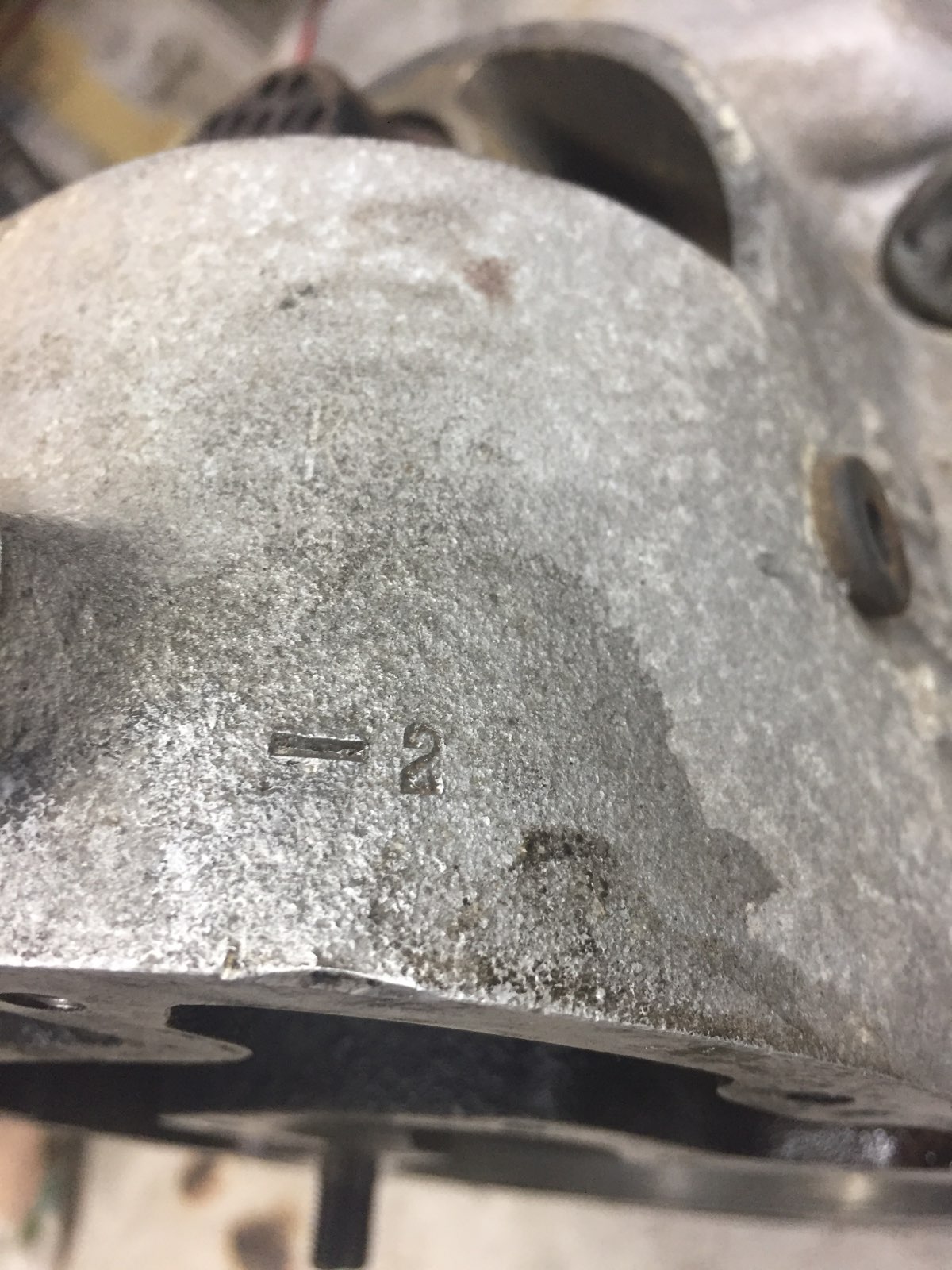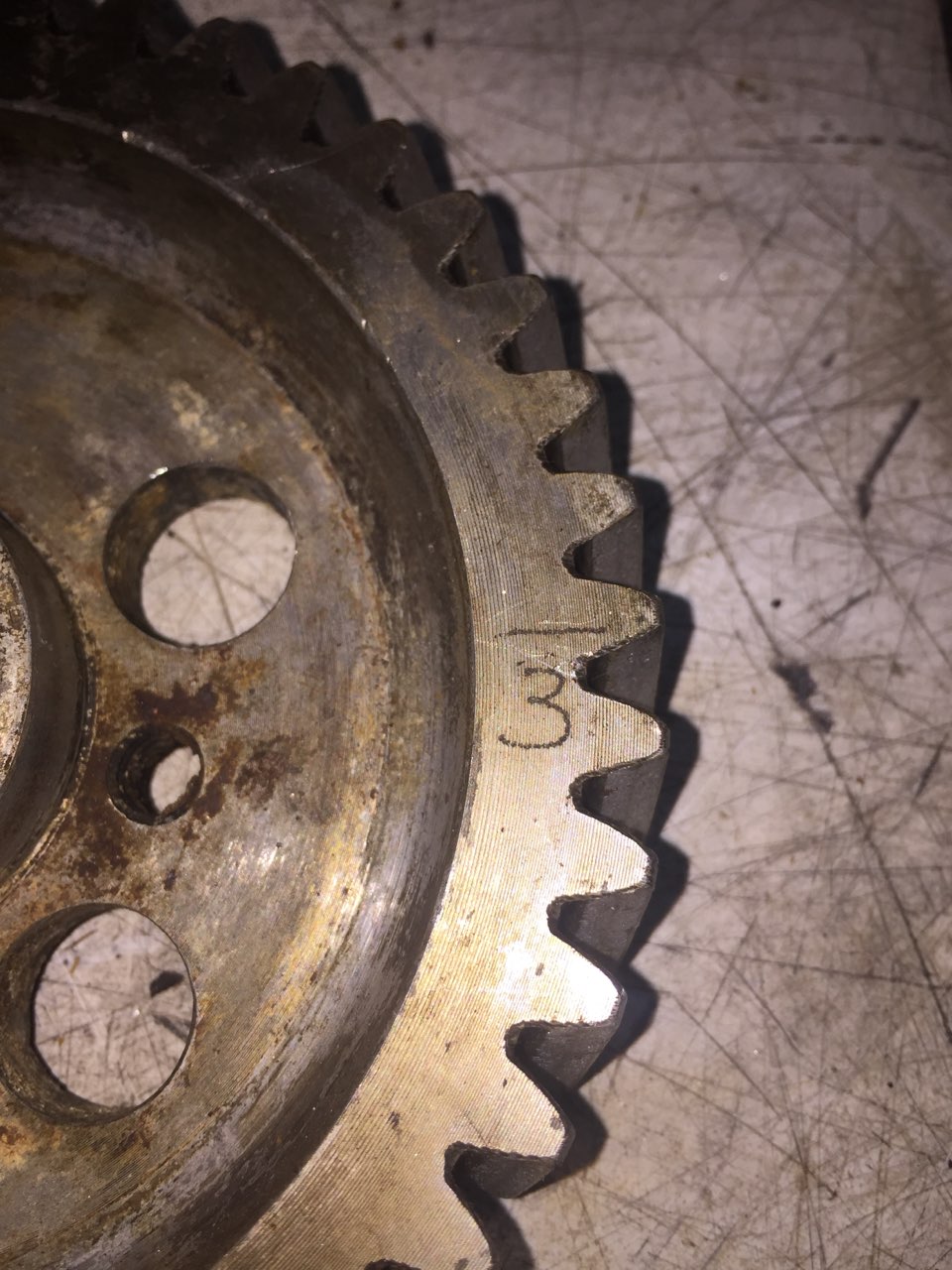Numbers punched into the /2 block
The slash 2 BMW motorcycle engine case has a number punched into the case near the top. That number tells us the size of the set of timing gears that was used in the original assembly.

This is a minus 2 case. At 12 O Clock, you can see the place that should have the cover that is over the air filter. This cover is often referred to as the “half-moon” cover. However, it is only a quarter of a circle. The air filter is that black thing with 5 holes in it. At 3 O, Clock is the black rubber grommet that centers the spark plug wire to the left cylinder. You can see a shadow to the left of the stamped in -2. The boss that holds the top motor mount is casting that shadow.
The cases had some variation in the distance between the centers of the camshaft and crankshaft. Since gears were used, not a chain, it was necessary to have a variety of gear sets to fit accurately.
The cases were made by one contractor and the gears by another contractor. The cam gear has the size of the set scratched into the aluminum; however, it can be hard to find.

This is an aluminum camshaft gear marked a minus 3. Not all scratched marks are that easy to see.
The gear sets run from -20 to +20. The range also has a -0, 0, and a +0. It might seem to some that zero is zero, but not to BMW. Zero represents the case with the perfect distance between the two shafts. A negative indicates that the two shafts are too close together and need a “minus” set of gears.
As the engine runs, the pistons try to “shove” the cylinders outwards and off the case.
I will work with round numbers to show the number of shoves. Assuming 100 k miles, at 4000 rpm, or about 60 mph, we get this number. Four thousand rpm represents one cylinder shove on each revolution. We get 4000 X 100,000 = 400 hundred million shoves. That is a lot of shoves.
The result of all of these shoves is that the case gets wider. As the case gets wider, it must get shorter to accommodate getting wider. The height of the case “shrinks” down a bit.
We sent dozens of lower ends to Roy Reynolds of Salt Lake City, Utah, for rebuilds. He claims that, on average, the case gets about 5 numbers shorter. So, if the engine started life off at zero, it might end up around a -5 for the next set of gears to fit correctly. That would be his first installation as a test. From there, he would be able to know if he needed a smaller or larger set. If the gears were too tight, they would whine and grind off the metal quickly. If the gears were too loose, they would have some play, and at idle rpm, one could hear them “clack” back and forth. This was because, at a very low rpm, the valve springs are shoving back on the pushrod and trying to change the direction of the camshaft.
Now the good news. As is natural, the gears are going to wear some amount. This wear could make the engine clack at low rpm. In practice, this doesn’t happen. As the gears wear, the two shafts are also coming closer together due to the shrinkage of height. An old tired engine with 100 k doesn’t make the clacking sound. Nice huh?
I remember Roy having to use a gear set that was eight numbers smaller on one of my engine rebuilds. This means that if it started at zero, it would now require a -8 set.
Now the bad news. If the case started with a -15, it would then need a -23 gear set. No such number existed. This would create a problem, but you will see a possible solution lower down, so keep reading.
Many have assumed that the individual gears would be identical if one had several gear sets of the same number. That would be wrong. The gears would probably be quite different in actual practice, but the distance between centers would be equal. Don’t mix and match them.
You can see that an engine rebuilder needs to have quite a variety of new gear sets to do the job correctly.
More good news. If the used gear set is still decent, reuse them. Back in the day, it might have mattered, but today almost nobody is going to put 100 k miles on a rebuilt /2 engine.
Now the bad news. How does one measure the used gear set? The wear isn’t equal around the circumference. It is greater at the time that the valve springs are pushing back on the pushrod and trying to make the cam change direction. Find that spot in the rotation and check the play. If it isn’t too bad, use the set. A person with lots of tuning experience may hear the clack at very low rpm. You probably won’t hear it, and you will be happy.
In the unlikely case that you need a -23 gear set, it is possible to make that gear set with some precise measurements of individual gear sizes. The good news is that you will be able to do your testing on old but decent used gears. Are you a machinist?
You should wish that your old /2 engine does not have anything more negative than a -10 stamped into the case.
For those doing a slinger cleaning, use the Many-in-One tool sold by Cycle Works. You will be able to evaluate the gears, but most likely, you will be able to reuse them.
Updated 15 July 2022
